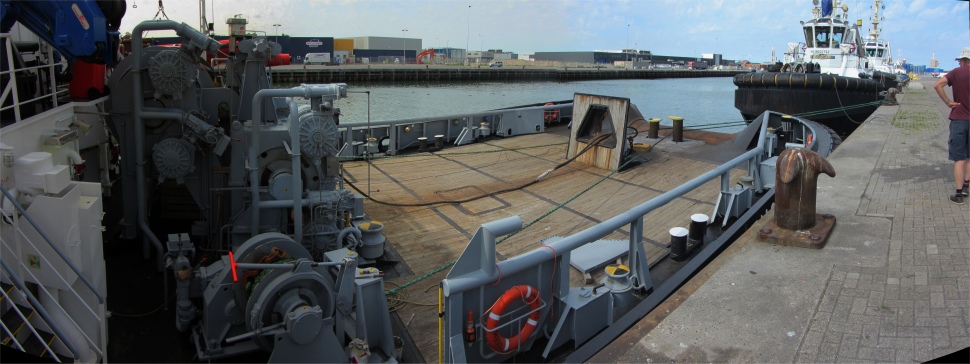 Powerful Tugs |
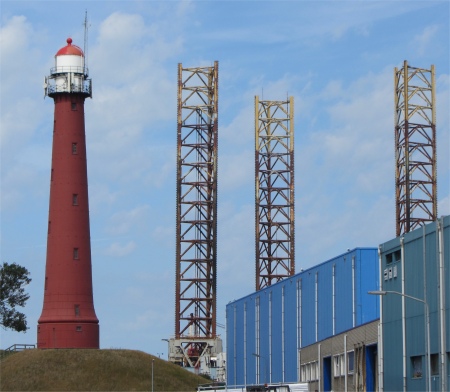 Lighthouse Dwarfed by Rig |
We checked the latest wind forecasts, and from the data we had available the optimum time would be around 5am on Friday morning. Rex busied himself entering the return trip into his navigational system.
We decided to head into the old section of Ijmuiden nearest us. In the 19th century there was a very strong desire to provide a fast shipping link between Amsterdam and the North Sea. The brothers-in-law Adrian Bik and Jan Willem Arnold, who had bought the Breesaap (area of land around Ijmuiden) in 1851 for one million Florins, sold a portion of the estate in 1863 to the Amsterdam Canal Company for the construction of the canal, resulting in excavation work commencing in 1865. Canal diggers from all over the Netherlands lived and worked in appalling conditions. The canal was completed in 1876, and William III of the Netherlands officially opened the Noordzeekanaal, connecting Amsterdam to the open sea and facilitating the growing shipping trade to Amsterdam. The new waterway, 20km long and 275m wide, ran straight through the dunes. Large parts of the Ij had to be reclaimed, and at the coast a large dam and harbour had to be built. At its mouth, where once the land was farmed by a handful of farmers, a new town now stood, Ijmuiden - mouth of the Ij. Navies who dug the canal later settled here, and many subsequently moved into the fishing industry.
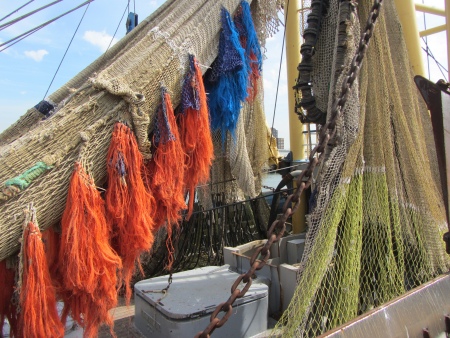 Colourful Fishing Nets |
By 1890 the town had about 1,500 inhabitants. The establishment, in 1917, of the steel producer Corus, formerly Koninklijke Hoogovens, whose chimneys dominate the area, was a direct result of the construction of this canal, and brought about a boom in the town. After the German invasion of the Netherlands on May 10th 1940, the Dutch Royal family left the country from Ijmuiden. The quays at Ijmuiden were crowded at that time with people desperate to be transported across the channel, sometimes at great expense. During the German occupation, the canal was out of operation and the Germans destroyed most of the town to create what they called Festung Ijmuiden (Fortress Ijmuiden), a heavily defended area in which the entire civilian population had been removed. Today, Ijmuiden has an imposing industrial terrain, ports and locks.
Our route took us through a maze of modern, industrial units which led us to the Harringhaven where every building, sight and smell was associated with the fishing industry. Large and small trawlers lay moored in this inner sanctum. One large vessel from Lowestoft had huge colourful nets dangling above it, with evidence of recent net mending exercises strewn as knots and cords on the quay alongside. Another boat was a large pot boat, the pots being the variety dropped onto the seabed to catch crab and lobsters, marked by tethered floating marker poles floating on the sea surface. This craft absolutely stunk, and it was a haven for flies. After a hefty lungful of the stench, we decided to purge ourselves and take time out to enjoy a coffee at one of many fishing product cafes that were clustered around the haven, and watched the world go by, or swim by as the case might be.
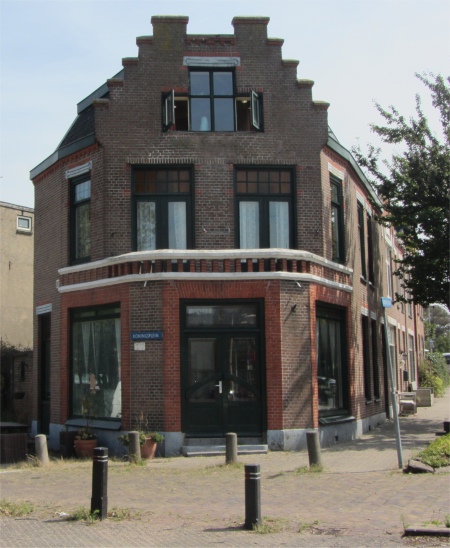 Rundown Koningsplein |
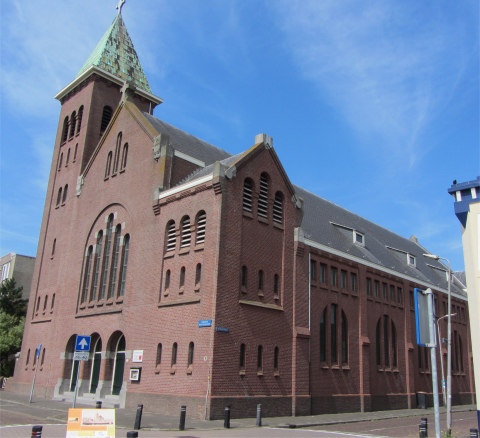 Engelmunduskerk |
The board marked part of a walking trail around the old part of the town. We followed the trail for a while, the boards showing old photographs of each locality from times gone by, but sadly all the text was in Dutch. Even the great linguist, Rex van Davenport, was stumped on some of this. Most of the buildings had long since disappeared, replaced by charmless bricks and mortar. The whole area seemed run down and neglected. Large sandy wastelands littered this side of town, and children's play areas lacked any stimulation.
 Old Clothes New |
 Tall British Yacht Next to a Barge |
At the end of President Kruger Street in Koningsplein there was once three houses that looked a cut above ordinary housing. There was a corner house whose surface was however not a square, but a triangle. Before the war the building housed a pharmacy, but it had to be deserted during World War II. The pharmacy never returned, and after the war the property was appointed as dry cleaners. The proprietors wanted an English sounding name for their business, and chose the name "Old New Clothes". Advertising agencies existed at that time, and for reasons best known to themselves, none of them pushed this business with the English name.
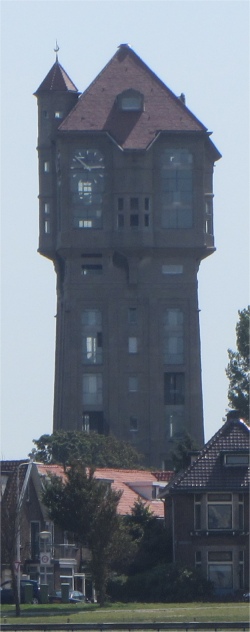 Old Water Tower |
The trail brought us to the Zuidersluis lock, the first lock to be built. We spent time here watching yachts enter the lock just as we had done less than 24 hours earlier. A very large British sailing yacht, complete with paid crew, and a mast four or five times taller than Duonita's, was moored on one side. Its graceful lines caught the attention of many admirers. We watched this superb craft leave the lock and majestically head out towards the North Sea.
We carried on to watch a large fuel barge in the Middensluis, completed in 1896. Moving on to the Noordersluis, opened in 1929, with a length of 400m, width 50m and depth of 15m, was for many years the largest lock in the world. We stood for a while watching two huge gas ships slowly edge their way out of this lock and head off to the North Sea. These locks were the most impressive I'd seen in the Netherlands so far.
We had walked a fair way to reach the locks, necessitating another break for a coffee and the compulsory visit to a chandlery for Rex's latest chart acquisition. The poor lad was dead on his feet, so we wound our way back through strong sunshine to Duonita. A fair breeze had picked up by this time. The latter part of our trek took us through a large concentration of concrete bunkers, a grim reminder of troubled times seventy years ago.
Our last evening meal in the Netherlands was at Restaurant Beaufort on the Ijmuiden side of the marina. The food was very good, and we managed to get chatting with the Chinese girl who had served us through the evening. She was actually Dutch, her Chinese parents living in Ijmuiden. Of course, being Dutch, she spoke excellent English.
She had studied graphics design at university, and had spent some time working in Hong Kong, which she really enjoyed despite being more crowded and busier than she would have liked. However, her father became ill, and so she returned to Ijmuiden. The Netherlands suited her in a way, since Chinese policy was work until you drop with a minimum of 12 hour working days. The Netherlands had a much more civilised approach to work ethic with a good work/life balance.
Her current work involved designing albums and CD covers, but her aspiration was to launch into food art. "What is that?" was the immediate question. She wanted to be creative with food, particularly vegetables, and make them artistically presentable so that children would enjoy eating vegetables more. Hmm... I have seen carved radishes and carrots at Asian restaurants before. Good for her I thought, despite her diminutive appearance, she certainly had big ambitions.

